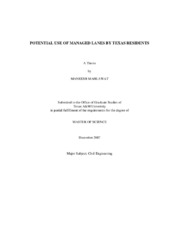| dc.description.abstract | Traffic congestion is a serious problem in the United States and is likely to get worse. A number of strategies encompassing increasing supply and managing demand have been suggested to mitigate the problem of traffic congestion. These strategies seek to reduce travel time and/or make travel time more reliable. The use of managed lanes is one such strategy. Faced with successful implementation of a managed lane strategy, it is important to understand potential public perception of the managed lane as well as estimate the number of travelers willing to use managed lanes. Such an estimate would help estimate the toll rates for optimal usage of managed lanes by carpoolers and toll paying travelers. An online survey augmented by paper and laptop survey was conducted in Houston and Dallas to collect information about travelers’ travel behavior, socio-economic characteristics, managed lane perception, and potential use of managed lanes. A comparison of interest in using managed lanes revealed that in majority of cases there was no difference in interest in using managed lanes across user groups. Travel time reliability and ability to travel faster were indicated as top two reasons for interest in managed lanes. This was true for all travelers regardless of mode. Mode choice model using multinomial logit modeling were estimated for Houston and Dallas. Simulation studies were conducted using these mode choice models to estimate the percentage of Single Occupant Vehicle (SOV) travelers on managed lane (ML), High Occupancy Vehicle with two travelers (HOV2) on ML, High Occupancy Vehicle with three or more travelers (HOV3+) on ML, SOV travelers on general purpose lane (GPL), HOV2 travelers on GPL, and HOV3+ travelers on GPL. These scenarios compared the managed lane usage for different speeds on GPL (25 miles per hour, 30 miles per hour, and 35 miles per hour). For the case when general purpose lane speed is 25 miles per hour, an increase of $11.75 in SOV tolls ($18 from $6.25) decreases the modal share of SOV travelers on Houston ML from 23.3 percent to 16.9 percent. A similar increase in Dallas tolls decreases the modal share of SOV ML travelers from 22.0 percent to 16.3 percent. | en |


